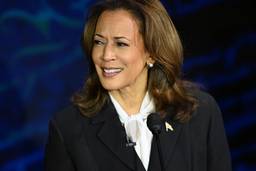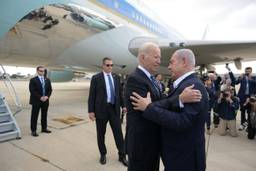Democrats Say Superdelegates Have Never Decided An Election. In 1984, They Thought the Opposite.
A review of newspaper reports from 1984 shows that Democratic officials believed the superdelegate system had “virtually assured” the nomination for the establishment candidate.
Branko Marcetic

It’s a firmly established defense of the superdelegate system that the 700 or so Democratic Party luminaries who can cast votes for any candidate of their choice have never once decided the nomination. DNC Chair Debbie Wasserman Schultz cited this in justifying their existence, and it popped up in Samantha Bee’s widely shared explanation-cum-defense of superdelegates. Rather than a mechanism for overturning the will of the voters, the argument goes, the superdelegates are simply a safeguard against an insurgent “fringe” candidate — say, the Democratic equivalent of a Donald Trump — drawing a huge primary turnout that isn’t representative of the larger Democratic electorate.
Yet in 1984, the first Democratic nomination contest in which superdelegates played a role, Democratic officials held a very different view. Many were quite sure the superdelegates had helped Walter Mondale secure the nomination.
Two years earlier, the Democratic Party had radically altered its nominating process to create superdelegates. Party officials thought primaries and caucuses were to blame for two landslide defeats in the past decade: of South Dakota Sen. George McGovern in 1972 and President Jimmy Carter in 1980. As a recent In These Times investigation found, a major fear was that primaries could allow “outsiders” to snatch the nomination. Superdelegates were instituted to prevent this.
When the 1984 convention rolled around, Democratic officials were pleased to see superdelegates had done their job.
Reporting from the convention, the Washington Post wrote that “There are those here who contend that [superdelegates’] presence may have saved the party’s national convention, and prospective presidential nominee, Walter F. Mondale, from disaster.”
Mondale, whom the Washington Post later referred to as “the very personification of the Washington political establishment,” had run a three-way race against Jesse Jackson and Sen. Gary Hart. Jackson remained solidly in third place, winning two contests and 18 percent of the vote, but the relatively young Hart, 48, launched a surprisingly strong bid for the nomination, winning 25 state primaries and caucuses to Mondale’s 21 (which included Puerto Rico).
It wasn’t that the superdelegates overturned the popular vote: In the end, Mondale narrowly beat Hart, 6.8 million to 6.5 million. But Democrats believed superdelegates had acted as a ballast throughout the contest to tip the balance toward Mondale and stave off his challengers.
Much as they have during this year’s campaign, superdelegates were key in giving the frontrunner an early momentum and establishing what appeared to be an insurmountable lead.
Beginning in 1983, the Mondale camp launched what the Washington Post called a “full-court press” to win House support, which involved the “foundation of respect” he had built among House members, but also the “cashing in on years of friendships, favors and fund-raising speeches.” Democratic members of the House of Representatives form a substantial bloc of the superdelegates: 164, to the Senate’s 25.
At the urging of the Mondale campaign, Speaker of the House Tip O’Neill scheduled the selection of House superdelegates for January 26, a month before Iowa and New Hampshire were due to vote. A Washington Post survey found that 95 of the newly selected superdelegates went for Mondale, more than five times as many as his nearest rival at that point, Ohio Sen. and former astronaut John Glenn. (Hart, whose campaign had yet to take off, received the support of only four.) As Brookings Institution Senior Fellow Elaine Kamarck later wrote, “In essence, this turned the House delegate selection contest into the first primary, a move that paid off richly for Mondale.”
As the Post put it, “House members played a key role in giving Mondale a head start on the extra delegates he needed to ensure himself the nomination.”
This pattern continued throughout the campaign. And, just as in the 2015-2016 primaries, superdelegates were regularly counted in the delegate totals by the media, giving Mondale an inflated lead over his rival. Kamarck noted that the superdelegates consistently boosted Mondale’s lead by 70 to 100 delegates, which “was especially useful in helping the Mondale campaign mask its losses on Super Tuesday.” On May 10, with eight primaries and caucuses to go, Mondale had a 5-to-1 lead among superdelegates.
Then as now, superdelegates often created a discrepancy between the winner of the popular vote in a state and the winner of the most delegates. Hart received fewer delegates than Mondale in nine of the states in which he was the victor, while Jackson, who won the plurality of the vote in Louisiana, was likewise overtaken by Mondale in that state’s delegate count. Of the 13 caucuses that Hart won, he only received the plurality of superdelegates in two.
Priscilla Southwell, a political science professor at the University of Oregon, wrote in 1986 that this lead “clearly gave Mondale’s candidacy a boost,” not to mention a psychological advantage.
Commenters at the time agreed. “They’ve virtually assured Fritz Mondale’s nomination,” Mickey Kantor, the California chairman of the Mondale delegation, told the Washington Post on July 18. (“Fritz” was an affectionate nickname often used for Mondale).
“Without the superdelegates,” a Democratic Congressional aide told the New York Times three days earlier, “Mondale might not be over the top right now.”
As was widely reported at the time, Mondale’s courting of the superdelegates was ultimately what put him over the 1,967-delegate threshold to win, thus avoiding a contested convention. Contested, or “brokered” conventions, take place when no candidate has a majority of delegates and there is thus no clear and definitive choice. The nominee is then decided by the delegates present voting freely for their preferred choice, sometimes in more than one round of voting.
Thanks in part to the three-way nature of the race, Mondale was 40 delegates short of this magic number by the time the convention rolled around, with only a slight lead in the popular vote. Professor Southwell posited that had he not been able to convince superdelegates to give him the extra boost he needed, Hart, who had launched a comeback in the final months of the campaign, may have been able to make a successful challenge for the nomination at the convention. However, Mondale’s “near-total domination” of the superdelegates, as the Boston Globe put it, made this a non-starter.
The Democrats’ corporate board of directors
Reports at the time also suggested that Mondale’s selection of New York Congresswoman Geraldine Ferraro as a running mate had a lot to do with her participation in the 1981-1982 Hunt Commission, which created the superdelegates.
Ferraro, a three-term Italian American congresswoman from Queens, was the first woman on a major-party ticket in history, and her inclusion was intended to bring excitement to an otherwise uninspiring campaign and appeal to ethnic groups like Italians that had abandoned the Democrats.
But her role in the Hunt Commission had also raised her visibility. As reported by In These Times, Ferraro had argued for elected officials to have a larger role in the nominating process because “no one is better able to represent [the grassroots] at the convention than a Member of Congress.” The New York Times quoted one Democratic party aide as recalling that she had “carried the water” for Congressional leaders by “advocating creation of the superdelegate system.” This, according to the Times, contributed significantly to her selection as VP.
Superdelegates also had a profound influence on that year’s party platform. Democratic officials and Hunt Commission members had complained that ever since 1970 reforms gave greater weight to primaries and caucuses, party bigwigs had been missing from the Democratic conventions, leading to the elevated influence of “factions” and “single-interest groups.”
As newspaper reports from 1984 make clear, the superdelegate system worked as intended by reversing these two trends. Party leaders told the New York Times that the 1982 reforms had created a nominating process “that favors mainstream candidates and policies.” An aide to Speaker O’Neill told the Washington Post that superdelegates had “curbed ideological excesses and ensured that the party would ‘not get caught up in political dead ends.’”
Indeed, the superdelegates helped defeat “a series of minority platform planks” that were advocated by both Hart and Jackson, keeping the Democratic party on the ideologically straight and narrow. Jackson had proposed planks that made “substantial” cuts to defense spending and promised “no first use” of nuclear weapons by the United States. He also put forward an affirmative action plan, which was watered down and adopted. Hart, meanwhile, put forward a failed plank to rein in the unilateral use of military force.
Other than Jackson’s affirmative action plan, the delegates rejected all of these as falling “outside the reasonable limits of their candidate’s views,” according to the New York Times. While thousands of words of new language from both camps were ultimately adopted, including a plank by Hart that criticized military intervention overseas, the final platform bore the mark of the superdelegates. While firmly in the sphere of New Deal politics, the final platform was more conservative than previous ones, mandating scaled-back social policies and strictly no new social spending, while leaving out “defense cuts that weaken our security,” as Mondale put it.
The New York Times heralded the platform as one “that avoids odd promises to obscure special interests,” calling it a “less measurable, but equally real, indication of the success of the latest rules changes.”
The superdelegate system gave elected officials “tremendous influence” in putting “oil between the wheels,” at the convention, as the chairman of the Democratic Congressional Campaign Committee explained at the time; or as Texas Sen. Lloyd Bentsen put it, it was an example of the superdelegates acting as a “board of directors,” stepping in to resolve internal divides.
Who were the superdelegates?
The superdelegates had something else in common with a corporate board of directors — they were relatively older, wealthier, whiter, more conservative and more likely to be men.
A New York Times survey that year of 1,561 delegates, including 523 of the 568 superdelegates, found that superdelegates tended to be “more experienced, more moderate and more loyal to the party than the delegates chosen by primaries and caucuses.” Twenty-one percent of pledged delegates identified as “very liberal” and 30 percent as “somewhat liberal,” compared to only 14 and 22 percent of superdelegates, respectively. Superdelegates also tended to be wealthier, with 25 percent making six figure incomes, compared to 10 percent of pledged delegates. Although no such comprehensive statistics on delegates exist today, there are good reasons to believe much of this remains true: Many superdelegates are office holders, who tend to be older and have deeper ties to the party, and the majority of whom are millionaires.
The survey also found that initial concerns by members of the Hunt Commission that creating a system where white men were “more equal than others” were largely justified. Unpledged delegates were 73 percent male and 82 percent white. Less than half of pledged delegates were men, though 75 percent were white.
The gap is less stark today, but at 58 percent male and 62 percent white, superdelegates continue to skew to a particular demographic.
A thumb on the scales
The 1984 race is not perfectly analogous to 2016. Hart was no Bernie Sanders. While he preached a post-Cold War foreign policy, railed against military aggression and energized and attracted young voters, independents and Republicans, he was also a post-New Deal Democrat whose “New Ideas” policies presaged the right-leaning New Democrat movement of Bill Clinton.
Still, his campaign stands today as arguably the clearest example of the way in which the Democratic nominating system can be leveraged by party insiders to influence an election — and to correct perceived deviations from political orthodoxies.
This can also be seen in the campaign of Jesse Jackson, who energized millions of black voters but felt the cards were stacked against him from start to finish. It would not be the last time Jackson tussled with the superdelegate system, complaining similarly in 1988 that the system was “inequitable” and “demonstrably unfair,” and calculating that his opponent held a 233 percent lead in superdelegates while he only had a 27 percent lead in votes.
If nothing else, it should give Democrats pause in thinking that superdelegates have never helped decide a nomination — and that they never will.
Branko Marcetic is a staff writer at Jacobin magazine and a 2019-2020 Leonard C. Goodman Institute for Investigative Reporting fellow. He is the author of Yesterday’s Man: The Case Against Joe Biden.








